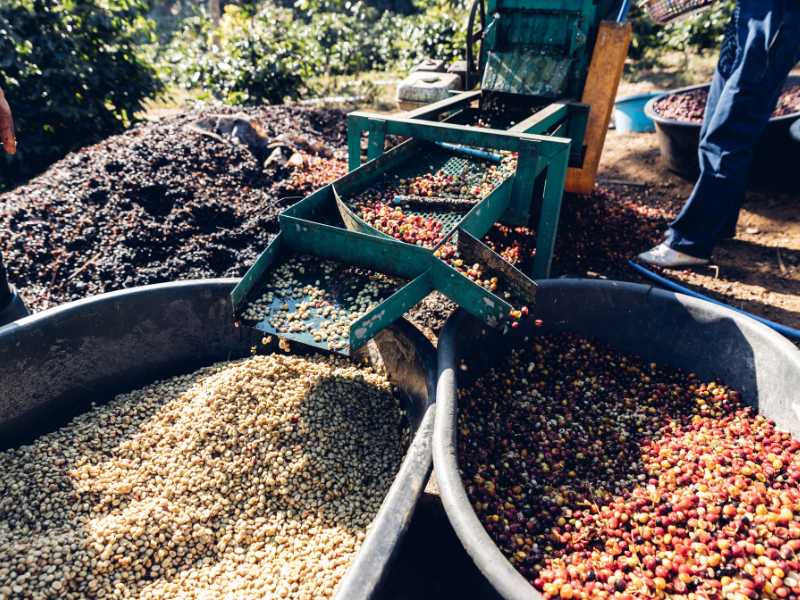Planting
Coffee seeds are planted in a shaded nursery over a large bed. The seedlings are watered regularly and protected from the sun. They are kept under shade until they are ready to be planted. The planting, however, takes place in the wet season when the soil is most moisturized and hydrated so that roots can firmly establish.
Harvesting
Once the coffee seed is planted permanently, it may take three to four years to flower and bear fruits (coffee cherry). When the coffee cherry is ripe and ready to harvest, it may turn into a deep red color. The coffee cherry is stripped and picked off the branch all at one time. In all coffee-producing contraries, the major harvest year is just once. The cherries that are at the peak of ripping are harvested. It may take many days for laborers on the field to hand-pick all the cherries that are ready to harvest.
Cherries Processing
After picking the cherries, the processing starts immediately to prevent any food spoilage. Usually, coffees are processed after picking in just one or two days. There are two methods of processing coffee – dry and wet.
The Dry Method
The dry method is an old-age method in which freshly harvested cherries are left under the sun to dry. To ensure they are completely dry, the cherries are turned and raked manually. At night and during the rain, they covered to prevent moisture from getting in the cherries. The process is continued for several weeks until all the moisture of the cheery drops to 11%.
The Wet Method
In the wet method, the freshly harvested cherries are put into pulping machines to remove the pulp from the cherries. After removing the pulp, only skin is left, which is easier to dry than the entire cherry. Then, the beans are passed through a water channel to separate heavy beans from lightweight beans.
The heavy beans sink in the water while the light-weighted beans float. The water channel passes through a series of drums that separate the lighter beans from heavier ones.
After separation, the beans are left in a water tank for fermentation. During this process, enzymes in the beans naturally remove parenchyma, a slick layer of mucilage, from the beans by dissolving it. The process takes somewhere about 12-48 hours. After the process, the beans feel rough to the touch and are dried under the sun until the moisture is about 11%.
Milling the Beas
The coffee beans are already ready, but before exporting them, the beans have to go through the following process:
Huldivng
The cherry beans are put into the hulling machine to remove the endocarp or parchment layer from the coffee beans. In the hauling, the entire dried husk of the bean is removed.
Polishing
It is an optional process, but many manufacturers use it to create high-quality coffee beans. Many believe that polished coffee beans are better than the unpolished, but the difference between the two is actually very small. In the polishing method, any silver skin left on the coffee beans during the hauling process is removed.
Grading and Sorting
The beans are screened for color and size. Air jets are also used to remove heavy beans from light beans. In this process, defective beans are removed. Large and small-sized beans are separated.
Exporting the Beans
The beans are now ready to be exported. They can be loaded and sent to their new owners, who make a good taste of coffee for you to brew. No! There is more to it. After the beans are exported and reach their new owners. The beans go through more steps to become ready for you.
Tasting The Coffee or Cupping
The coffee is tested many times for quality and taste. A coffee taster, usually known as a cupper, evaluates the beans on various parameters. A small portion of beans are roasted and infused in boiling water at a controlled temperature. The cupper smells the aroma of the freshly prepared coffee and judges its quality. To taste the coffee, the cupper slurps a spoonful of coffee quickly for the cupper's taste buds to evaluate the taste. The cupper also weighed the coffee on the tongue and spit it out.
The tasting of the coffee takes place every day to blend coffee beans and ensure the good quality of coffee reaches the consumers.
Roasting the Coffee
The exported coffee beans are green in color and are roasted after the cupper approves them for a richer brown color. The beans are roasted at a temperature of 550 degrees Fahrenheit. The beans are rotated throughout the process, so each coffee bean is roasted completely. The roasting continues until the temperature of the coffee beans reaches 400 degrees Fahrenheit. After roasting, the beans are immediately cooled.
Grinding
The roasted coffee beans are then ground to pack and sent to you for brewing. Some coffee beans are finely ground, especially coffees for espresso. The purpose of grinding is to get all the best flavors of coffee in a cup. The finely ground beans are packed and sent to coffee suppliers, and then they are further repacked to reach your doorsteps. So this is how your favorite coffee is prepared.

